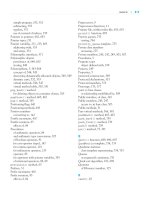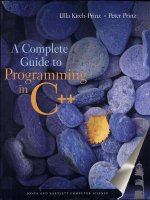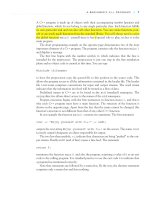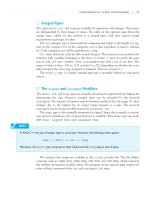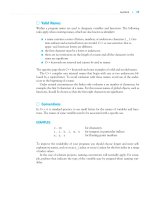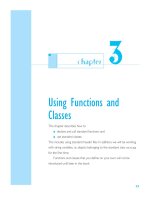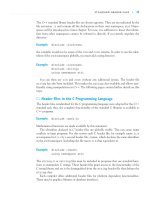A Complete Guide to Programming in C++ part 1 ppsx
Bạn đang xem bản rút gọn của tài liệu. Xem và tải ngay bản đầy đủ của tài liệu tại đây (293.84 KB, 10 trang )
A Complete Guide to
Programming in C++
Ulla Kirch-Prinz
Peter Prinz
JONES AND BARTLETT PUBLISHERS
Ulla Kirch-Prinz
Peter Prinz
A Complete Guide to
Programming in C++
World Headquarters
Jones and Bartlett Publishers
40 Tall Pine Drive
Sudbury, MA 01776
978-443-5000
www.jbpub.com
Jones and Bartlett Publishers
Canada
2406 Nikanna Road
Mississauga, ON L5C 2W6
CANADA
Jones and Bartlett Publishers
International
Barb House, Barb Mews
London W6 7PA
UK
Copyright © 2002 by Jones and Bartlett Publishers, Inc.
All rights reserved. No part of the material protected by this copyright notice may be reproduced or utilized in
any form, electronic or mechanical, including photocopying, recording, or any information storage or retrieval
system, without written permission from the copyright owner.
Cover Image: Stones on shore-line and yellow leaf, Bjorkliden, Sweden, by Peter Lilja
Library of Congress Cataloging-in-Publication Data
Prinz, Peter.
[C++ Lernen und professionell anwenden. English]
A complete guide to programming in C++ / Peter Prinz, Ulla Kirch-Prinz; translated by Ian Travis.
p. cm.
ISBN: 0-7637-1817-3
1. C++ (Computer program language) I. Kirch-Prinz, Ulla. II. Title.
QA76.73.C153 P73713 2001
005.13'3—dc21 2001029617
2090
Chief Executive Officer: Clayton Jones
Chief Operating Officer: Don W. Jones, Jr.
V.P., Managing Editor: Judith H. Hauck
V.P., Design and Production: Anne Spencer
V.P., Manufacturing and Inventory Control: Therese Bräuer
Editor-in-Chief: Michael Stranz
Development and Product Manager: Amy Rose
Marketing Manager: Nathan Schultz
Production Assistant: Tara McCormick
Cover Design: Night & Day Design
Composition: Northeast Compositors
Text Design: Mary McKeon
Printing and Binding: Courier Westford
Cover printing: John Pow Company, Inc.
This book was typeset in QuarkXpress 4.11 on a Macintosh G4. The font families used were Goudy, Gill Sans,
Courier, Rubino Serif, and Seven Sans. The first printing was printed on 50 lb. Finch Opaque.
Printed in the United States of America
05 04 03 02 01 10 9 8 7 6 5 4 3 2 1
Dedicated to our children, Vivi and Jeany
This page intentionally left blank
v
This book was written for readers interested in learning the C++ programming
language from scratch, and for both novice and advanced C++ programmers
wishing to enhance their knowledge of C++. It was our goal from the begin-
ning to design this text with the capabilities of serving dual markets, as a text-
book for students and as a holistic reference manual for professionals.
The C++ language definition is based on the American National Stan-
dards Institute ANSI Standard X3J16. This standard also complies with ISO
norm 14882, which was ratified by the International Standardization Organi-
zation in 1998. The C++ programming language is thus platform-independent
in the main with a majority of C++ compilers providing ANSI support. New
elements of the C++ language, such as exception handling and templates, are
supported by most of the major compilers. Visit the Jones and Bartlett web site
at www.jbpub.com for a listing of compilers available for this text.
The chapters in this book are organized to guide the reader from elemen-
tary language concepts to professional software development, with in-depth
coverage of all the C++ language elements en route. The order in which these
elements are discussed reflects our goal of helping the reader to create useful
programs at every step of the way.
preface
Each double-page spread in the book is organized to provide a description of the lan-
guage elements on the right-hand page while illustrating them by means of graphics and
sample programs on the left-hand page. This type of visual representation offered by each
spread will provide students and professionals with an unmatched guide throughout the
text. The sample programs were chosen to illustrate a typical application for each lan-
guage element. In addition, filter programs and case studies introduce the reader to a
wide range of application scenarios.
To gain command over a programming language, students need a lot of experience in
developing programs. Thus, each chapter includes exercises followed by sample solu-
tions, allowing the reader to test and enhance his or her performance and understanding
of C++.
The appendix provides further useful information, such as binary number representa-
tion, pre-processor directives, and operator precedence tables, making this book a well-
structured and intelligible reference guide for C++ programmers.
In order to test and expand your acquired knowledge, you can download sample pro-
grams and solutions to the exercises at:
Content Organization
Chapter 1 gives a thorough description of the fundamental characteristics of the object-
oriented C++ programming language. In addition, students are introduced to the steps
necessary for creating a fully functional C++ program. Many examples are provided to
help enforce these steps and to demonstrate the basic structure of a C++ program.
Chapter 2 provides a complete introduction to the basic types and objects used by
C++ programs. Integral types and constants, fundamental types, and Boolean constants
are just a few of the topics discussed.
Chapter 3 describes how to declare and call standard functions. This chapter also
teaches students to use standard classes, including standard header files. In addition, stu-
dents work with string variables for the first time in this chapter.
Chapter 4 explains the use of streams for input and output, with a focus on formatting
techniques. Formatting flags and manipulators are discussed, as are field width, fill char-
acters, and alignment.
Chapter 5 introduces operators needed for calculations and selections. Binary, unary,
relational, and logical operators are all examined in detail.
Chapter 6 describes the statements needed to control the flow of a program. These
include loops with while, do-while, and for; selections with if-else, switch, and the condi-
tional operator; and jumps with goto, continue, and break.
Chapter 7 provides a thorough introduction to the definition of symbolic constants
and macros, illustrating their significance and use. Furthermore, a comprehensive exami-
nation of standard macros for character handling is included.
Chapter 8 introduces implicit type conversions, which are performed in C++ when-
ever different arithmetic types occur in expressions. Additionally, the chapter explores
an operator for explicit type conversion.
vi
■
PREFACE
Chapter 9 takes an in-depth look at the standard class string, which is used to repre-
sent strings. In addition to defining strings, the chapter looks at the various methods of
string manipulation. These include inserting and erasing, searching and replacing, com-
paring, and concatenating strings.
Chapter 10 describes how to write functions of your own. The basic rules are covered,
as are passing arguments, the definition of inline functions, overloading functions and
default arguments, and the principle of recursion.
Chapter 11 gives a thorough explanation of storage classes for objects and functions.
Object lifetime and scope are discussed, along with global, static, and auto objects.
Namespaces and external and static functions are also included in the discussion.
Chapter 12 explains how to define references and pointers and how to use them as
parameters and/or return values of functions. In this context, passing by reference and
read-only access to arguments are introduced.
Chapter 13 provides a complete description of how classes are defined and how
instances of classes, or objects, are used. In addition, structs and unions are introduced as
examples of special classes.
Chapter 14 describes how constructors and destructors are defined to create and
destroy objects. Also discussed are how inline methods, access methods, and read-only
methods can be used. Furthermore, the chapter explains the pointer this, which is avail-
able for all methods, and what you need to pay attention to when passing objects as argu-
ments or returning objects.
Chapter 15 gives a complete explanation of member objects and how they are initial-
ized, and of data members that are created only once for all the objects in a class. In addi-
tion, this chapter describes constant members and enumerated types.
Chapter 16 takes an in-depth look at how to define and use arrays. Of particular inter-
est are one-dimensional and multidimensional arrays, C strings, and class arrays.
Chapter 17 describes the relationship between pointers and arrays. This includes
pointer arithmetic, pointer versions of functions, pointers as return values and read-only
pointers, and pointer arrays. Students learn that operations that use C strings illustrate
how to use pointers for efficient programming, and that string access via the command
line of an application program is used to illustrate pointer arrays.
Chapter 18 explains sequential file access using file streams. Students will develop an
understanding of how file streams provide simple and portable file handling techniques.
Chapter 19 provides a complete description of the various uses of overloaded opera-
tors. Arithmetic operators, comparisons, the subscript operator, and the shift operators
for input and output are overloaded to illustrate the appropriate techniques. In addition,
the concept of friend functions, which is introduced in this context, is particularly
important for overloading operators. Students learn how overloading operators allows
them to apply existing operators to objects of class type.
Chapter 20 discusses how implicit type conversion occurs in C++ when an expression
cannot be compiled directly but can be compiled after applying a conversion rule. The
programmer can stipulate how the compiler will perform implicit type conversion for
classes by defining conversion constructors and functions. Finally, the chapter discusses
ambiguity that occurs due to type conversion and how to avoid it.
PREFACE
■
vii
Chapter 21 describes how a program can allocate and release memory dynamically in
line with current memory requirements. Dynamic memory allocation is an important fac-
tor in many C++ programs, and the following chapters contain several case studies to
help students review the subject.
Chapter 22 explains how to implement classes containing pointers to dynamically
allocated memory. These include your own copy constructor definition and overloading
the assignment operator. A class designed to represent arrays of any given length is used
as a sample application.
Chapter 23 provides a thorough description of how derived classes can be constructed
from existing classes by inheritance. In addition to defining derived classes, this chapter
discusses how members are redefined, how objects are constructed and destroyed, and
how access control to base classes can be realized.
Chapter 24 discusses implicit type conversion within class hierarchies, which occurs
in the context of assignments and function calls. Explicit type casting in class hierar-
chies is also described, paying particular attention to upcasting and downcasting.
Chapter 25 gives a complete explanation of how to develop and manage polymorphic
classes. In addition to defining virtual functions, dynamic downcasting in polymorphic
class hierarchies is introduced.
Chapter 26 describes how defining pure virtual methods can create abstract classes
and how you can use abstract classes at a polymorphic interface for derived classes. To
illustrate this, an inhomogeneous list, that is, a linked list whose elements can be of vari-
ous class types, is implemented.
Chapter 27 describes how new classes are created by multiple inheritance and
explains their uses. Besides introducing students to the creation and destruction of
objects in multiply-derived classes, virtual base classes are depicted to avoid ambiguity in
multiple inheritance.
Chapter 28 explains how a C++ program uses error-handling techniques to resolve
error conditions. In addition to throwing and catching exceptions, the chapter also
examines how exception specifications are declared and exception classes are defined. In
addition, the use of standard exception classes is discussed.
Chapter 29 examines random access to files based on file streams, and options for
querying file state. Exception handling for files is discussed as well. The chapter illus-
trates how to make objects in polymorphic classes persistent, that is, how to save them in
files. The applications introduced in this chapter include simple index files and hash
tables.
Chapter 30 provides a thorough explanation of the advanced uses of pointers. These
include pointers to pointers, functions with a variable number of arguments, and pointers
to functions. In addition, an application that defines a class used to represent dynamic
matrices is introduced.
Chapter 31 describes bitwise operators and how to use bit masks. The applications
included demonstrate calculations with parity bits, conversion of lowercase and capital
letters, and converting binary numbers. Finally, the definition of bit-fields is introduced.
Chapter 32 discusses how to define and use function and class templates. In addition,
special options, such as default arguments, specialization, and explicit instantiation, are
viii
■
PREFACE
